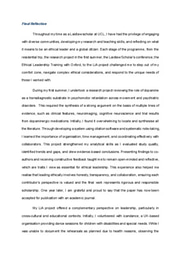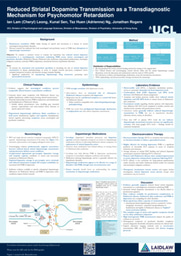Psychomotor Retardation and Dopamine Dysfunction: A Transdiagnostic Phenomenon - Laidlaw Research Report 2024
This project aimed to investigate the hypothesis that reduced striatal dopamine transmission is a transdiagnostic mechanism underlying psychomotor retardation — a visible generalised slowing of speech and movement — across various neurological and psychiatric conditions. Previous research has suggested that both neurological and psychiatric causes of psychomotor retardation share common features, particularly disruptions in dopaminergic transmission. Most notably, Parkinson’s disease, characterised by the degeneration of dopaminergic neurons in the substantia nigra pars compacta, is associated with cardinal symptoms such as hypokinesia, bradykinesia and rigidity, which fall under the scope of psychomotor retardation. Identifying shared pathophysiological mechanisms could have clinical implications for more personalised treatments and advance our understanding of the dopamine system’s role in neuropsychiatric conditions, potentially informing the repurposing of dopaminergic drugs.
Therefore, the research focused on determining the anatomical and mechanistical specifics of striatal dopamine transmission in neuropsychiatric conditions, in terms of synaptic locations (pre/post), components (nerve terminal/transporter/receptor) and functions (storage/reuptake/binding). Additionally, it explored whether physical movement could be regarded as a window into cognition. Using a narrative review approach, this research analysed evidence from clinical features, laboratory markers, molecular neuroimaging, epidemiology and responses to dopaminergic medication and electroconvulsive therapy to evaluate the hypothesis.
The findings generally support the hypothesis that reduced striatal dopaminergic transmission serves as a transdiagnotic mechanism for psychomotor retardation across various conditions. While reduced transmission may contribute to the pathophysiology of PMR, it may not be the sole cause. Although current evidence is insufficient to conclusively define anatomical and mechanistic specificities, there is speculation that dorsal striatal pre-synaptic dysfunctions in dopamine storage and reuptake affects downstream neurotransmission, which is reflected as changes in post-synaptic dopamine D2 receptor availability. Striatal dopamine should be considered alongside other neurotransmitters, with further investigation needed on medication action sites and the anatomical and mechanistic specifics of striatal dopaminergic transmission.




Please sign in
If you are a registered user on Laidlaw Scholars Network, please sign in